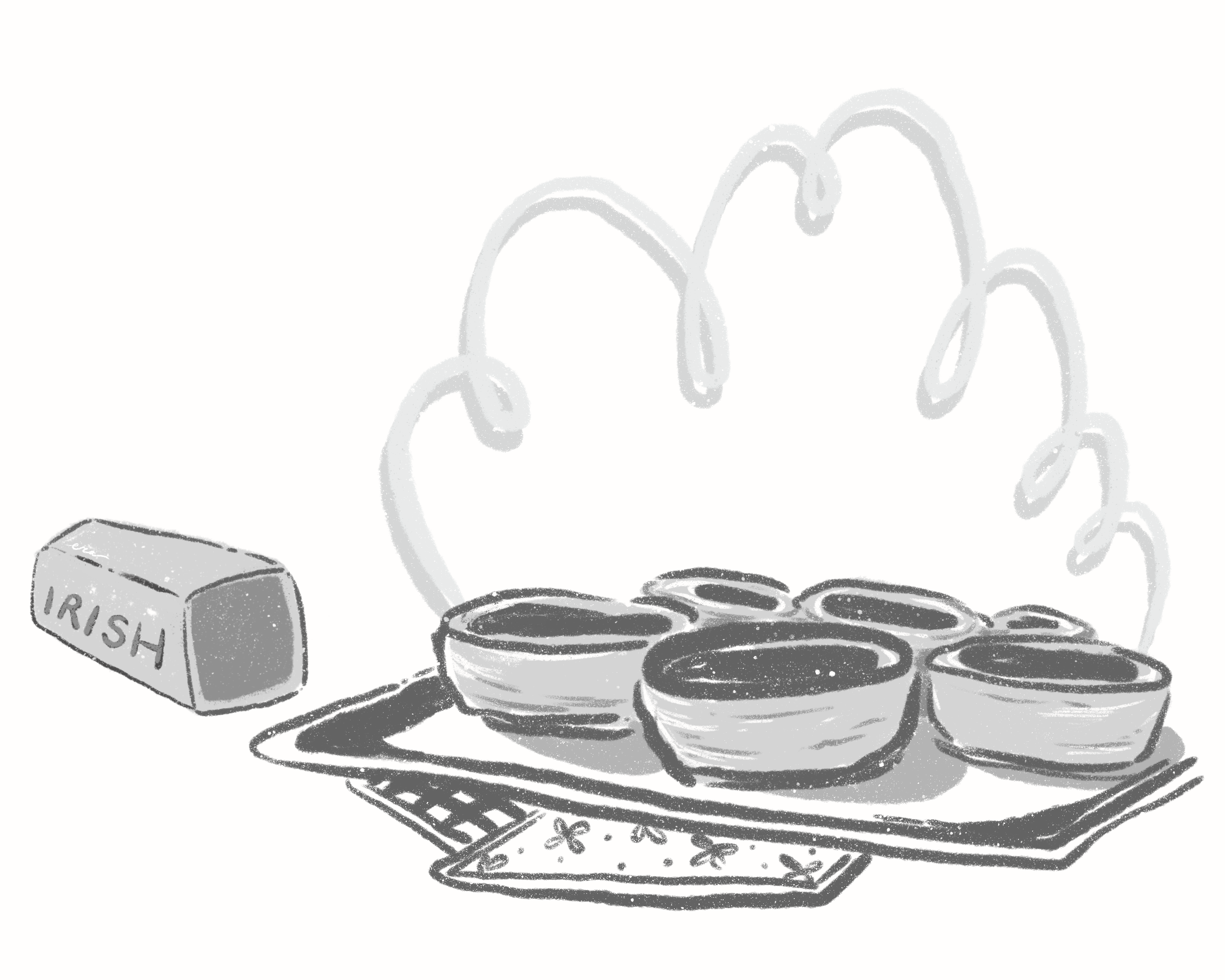To answer your question
March 3, 2023
 Eva Ahn
Eva AhnWhy buy local when you can buy Irish?
Victoria and I stood in the dairy aisle of Hannaford, debating our many selections for the butter that would go into the puff pastry for this week’s dessert: egg tarts. Staring at the various butters in their tubs and boxes and papers, lined up like glossy bricks shining under the sharp light of the fridge, we decided that this week we were going to splurge.
Puff pastry is a finicky thing to make, simply because it’s far too likely to go wrong. It requires a laminated dough repeatedly folded over with butter to create multiple thin layers. If the dough is not folded enough times or is not cooled enough in between folds, or the butter is not evenly distributed, the pastry may be hard or far too dense.
Butter, the key ingredient, is absolutely necessary for creating the flaky and airy texture of puff pastry and for producing a rich flavor. The only question was whether to buy the expensive butter from a local Maine farm or the expensive butter from Ireland.
In the end, we walked out of Hannaford’s with eight ounces of pure Irish butter. Most European butters have a higher butterfat content than those from the U.S., leading to a richer and softer butter. These butters’ deep yellow color comes from cows who have a natural grass fed diet, compared to the whiter butters derived from a grain diet. Our selection did not disappoint.
This week, for the first time, we enjoyed our dessert creation at Boody Johnson. Sitting in a circle in the barn, with two pans of steaming egg tarts in front of us and the snow falling whimsically outside the giant window, I couldn’t have hoped for a cozier indoor winter activity than this. After introductions, everyone in the group went around and shared a dish that reminded them of home. Mario vigorously praised his mother’s chocoflan. Mingi expressed his love of LA tacos and bingsu, which is a Korean shaved ice. Isabelle missed simply receiving cut fruit from her mom as a snack. It warmed my heart to hear the many cultural identities that shaped peoples’ experiences with food. Despite the diversity of our answers, we were all able to understand the joy, the relationships and the memories that food can incite.
When I was younger, the idea of finding such a warm, open and accepting community would have been a dream. Growing up in Maine and attending a predominantly white school for the entirety of my elementary years, my relationship with food was something I felt the need to conceal. My favorite dish was sushi. Everytime I discovered my mom making it, I’d feel my heart balloon with excitement. It wasn’t until the very first time I brought sushi to school that I was made fun of and isolated at the cafeteria lunch table. The joy of eating my favorite food suddenly became paired with a polarizing shame. Who would have guessed that social culture in America would come to embrace sushi as one of the most popular international dishes?
The biggest project of eighth grade was to select a country on which we would write a ten-page research paper, give a presentation to our classmates and bring in a traditional dish. I made a three course meal consisting of sesame chicken, spring rolls and, for dessert, Chinese egg tarts. At the end of my presentation, with everyone eating happily, the teacher called for questions from classmates. While eating the food that I had spent all day cooking, after having begged the teacher to get up for seconds, still chewing and mid-swallowing, one boy asked, “Is it true that in China, you guys eat dogs and cats?” Standing at the front of the room, with all eyes on me and a heavy silence swallowing up the air like static, I initially felt a slight jolt of fear.
The anxiety quickly faded away. After his question, I couldn’t help but feel a sense of relief. It was as if I had been waiting for this question all along—that this prediction had been looming in the back of my head for the entirety of my presentation, and that the very point of my presentation was simply a means of providing the opportunity for him to ask it. Now that it had happened, this moment would pass and I would be able to move on. I had done my part. I had played my role perfectly.
Despite always having my racial and ethnic background become a greater target against my identity as a whole, my project on China is a memory I look back on fondly. It was an opportunity to learn from my mother, to connect with my culture and to cook new dishes. Now, at Bowdoin, I continue to cook, to study and to work hard with the same level of tenacity and dedication and care with which I approached the project. Most of all, I have confidence that those I share both my experiences and my food with will reciprocate with love and compassion.

Comments
Before submitting a comment, please review our comment policy. Some key points from the policy: